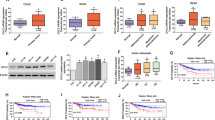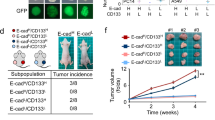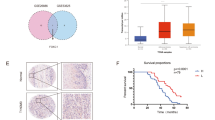Abstract
Primary or acquired drug resistance accounts for the failure of chemotherapy and cancer recurrence in esophageal squamous cell carcinoma (ESCC). However, the aberrant mechanisms driving drug resistance are not fully understood in ESCC. In our previous study, FAT Atypical Cadherin 1 (FAT1) was found to inhibit the epithelial–mesenchymal transition (EMT) process in ESCC. EMT plays a critical role in the development of drug resistance in multiple cancer types. Besides, it equips cancer cells with cancer stem cell (CSC)-like characters that also are associated with chemotherapy resistance. Whether FAT1 regulates the stemness or drug resistance of ESCC cells is worth being explored. Here we found that FAT1 was downregulated in ESCC spheres and negatively correlated with stemness-associated markers including ALDH1A1 and KLF4. Knocking down FAT1 enhanced the sphere-forming ability, resistance to cisplatin and drug efflux of ESCC cells. Additionally, FAT1 knockdown upregulated the expression of drug resistance-related gene ABCC3. Furtherly, we found FAT1 knockdown induced the translocation of β-catenin into nucleus and enhanced its transcriptional activity. The result of ChIP showed that β-catenin was enriched in ABCC3 promoter. Furthermore, β-catenin promoted expression of ABCC3. In conclusion, FAT1 knockdown might enhance the stemness and ABCC3-related cisplatin resistance of ESCC cells via Wnt/β-catenin signaling pathway. FAT1 and its downstream gene ABCC3 might be potential targets for overcoming chemoresistance in ESCC.







Similar content being viewed by others
Data availability
The analyzed data sets generated during the present study are available from the corresponding author on reasonable request.
References
Bray F, Ferlay J, Soerjomataram I, Siegel RL, Torre LA, Jemal A (2018) Global cancer statistics 2018: GLOBOCAN estimates of incidence and mortality worldwide for 36 cancers in 185 countries. CA Cancer J Clin 68:394–424. https://doi.org/10.3322/caac.21492
Arnold M, Soerjomataram I, Ferlay J, Forman D (2015) Global incidence of oesophageal cancer by histological subtype in 2012. Gut 64:381–387. https://doi.org/10.1136/gutjnl-2014-308124
Wang T, Yu J, Liu M, Chen Y, Zhu C, Lu L, Wang M, Min L, Liu X, Zhang X, Gubat JA, Chen Y (2019) The benefit of taxane-based therapies over fluoropyrimidine plus platinum (FP) in the treatment of esophageal cancer: a meta-analysis of clinical studies. Drug Des Dev Ther 13:539–553. https://doi.org/10.2147/DDDT.S189514
Ando N, Kato H, Igaki H, Shinoda M, Ozawa S, Shimizu H, Nakamura T, Yabusaki H, Aoyama N, Kurita A, Ikeda K, Kanda T, Tsujinaka T, Nakamura K, Fukuda H (2012) A randomized trial comparing postoperative adjuvant chemotherapy with cisplatin and 5-fluorouracil versus preoperative chemotherapy for localized advanced squamous cell carcinoma of the thoracic esophagus (JCOG9907). Ann Surg Oncol 19:68–74. https://doi.org/10.1245/s10434-011-2049-9
Ter Veer E, Haj Mohammad N, van Valkenhoef G, Ngai LL, Mali RMA, Anderegg MC, van Oijen MGH, van Laarhoven HWM (2016) The efficacy and safety of first-line chemotherapy in advanced esophagogastric cancer: a network meta-analysis. J Natl Cancer Inst. https://doi.org/10.1093/jnci/djw166
Ilson DH (2008) Esophageal cancer chemotherapy: recent advances. Gastrointest Cancer Res 2:85–92
Altorki N, Harrison S (2017) What is the role of neoadjuvant chemotherapy, radiation, and adjuvant treatment in resectable esophageal cancer? Ann Cardiothorac Surg 6:167–174. https://doi.org/10.21037/acs.2017.03.16
Shibue T, Weinberg RA (2017) EMT, CSCs, and drug resistance: the mechanistic link and clinical implications. Nat Rev Clin Oncol 14:611–629. https://doi.org/10.1038/nrclinonc.2017.44
Farmer P, Bonnefoi H, Anderle P, Cameron D, Wirapati P, Becette V, Andre S, Piccart M, Campone M, Brain E, Macgrogan G, Petit T, Jassem J, Bibeau F, Blot E, Bogaerts J, Aguet M, Bergh J, Iggo R, Delorenzi M (2009) A stroma-related gene signature predicts resistance to neoadjuvant chemotherapy in breast cancer. Nat Med 15:68–74. https://doi.org/10.1038/nm.1908
Scheel C, Eaton EN, Li SH, Chaffer CL, Reinhardt F, Kah KJ, Bell G, Guo W, Rubin J, Richardson AL, Weinberg RA (2011) Paracrine and autocrine signals induce and maintain mesenchymal and stem cell states in the breast. Cell 145:926–940. https://doi.org/10.1016/j.cell.2011.04.029
Ni T, Li XY, Lu N, An T, Liu ZP, Fu R, Lv WC, Zhang YW, Xu XJ, Grant Rowe R, Lin YS, Scherer A, Feinberg T, Zheng XQ, Chen BA, Liu XS, Guo QL, Wu ZQ, Weiss SJ (2016) Snail1-dependent p53 repression regulates expansion and activity of tumour-initiating cells in breast cancer. Nat Cell Biol 18:1221–1232. https://doi.org/10.1038/ncb3425
Zhang L, Zhou Y, Cheng C, Cui H, Cheng L, Kong P, Wang J, Li Y, Chen W, Song B, Wang F, Jia Z, Li L, Li Y, Yang B, Liu J, Shi R, Bi Y, Zhang Y, Wang J, Zhao Z, Hu X, Yang J, Li H, Gao Z, Chen G, Huang X, Yang X, Wan S, Chen C, Li B, Tan Y, Chen L, He M, Xie S, Li X, Zhuang X, Wang M, Xia Z, Luo L, Ma J, Dong B, Zhao J, Song Y, Ou Y, Li E, Xu L, Wang J, Xi Y, Li G, Xu E, Liang J, Yang X, Guo J, Chen X, Zhang Y, Li Q, Liu L, Li Y, Zhang X, Yang H, Lin D, Cheng X, Guo Y, Wang J, Zhan Q, Cui Y (2015) Genomic analyses reveal mutational signatures and frequently altered genes in esophageal squamous cell carcinoma. Am J Hum Genet 96:597–611. https://doi.org/10.1016/j.ajhg.2015.02.017
Lin DC, Hao JJ, Nagata Y, Xu L, Shang L, Meng X, Sato Y, Okuno Y, Varela AM, Ding LW, Garg M, Liu LZ, Yang H, Yin D, Shi ZZ, Jiang YY, Gu WY, Gong T, Zhang Y, Xu X, Kalid O, Shacham S, Ogawa S, Wang MR, Koeffler HP (2014) Genomic and molecular characterization of esophageal squamous cell carcinoma. Nat Genet 46:467–473. https://doi.org/10.1038/ng.2935
Gao YB, Chen ZL, Li JG, Hu XD, Shi XJ, Sun ZM, Zhang F, Zhao ZR, Li ZT, Liu ZY, Zhao YD, Sun J, Zhou CC, Yao R, Wang SY, Wang P, Sun N, Zhang BH, Dong JS, Yu Y, Luo M, Feng XL, Shi SS, Zhou F, Tan FW, Qiu B, Li N, Shao K, Zhang LJ, Zhang LJ, Xue Q, Gao SG, He J (2014) Genetic landscape of esophageal squamous cell carcinoma. Nat Genet 46:1097–1102. https://doi.org/10.1038/ng.3076
Song Y, Li L, Ou Y, Gao Z, Li E, Li X, Zhang W, Wang J, Xu L, Zhou Y, Ma X, Liu L, Zhao Z, Huang X, Fan J, Dong L, Chen G, Ma L, Yang J, Chen L, He M, Li M, Zhuang X, Huang K, Qiu K, Yin G, Guo G, Feng Q, Chen P, Wu Z, Wu J, Ma L, Zhao J, Luo L, Fu M, Xu B, Chen B, Li Y, Tong T, Wang M, Liu Z, Lin D, Zhang X, Yang H, Wang J, Zhan Q (2014) Identification of genomic alterations in oesophageal squamous cell cancer. Nature 509:91–95. https://doi.org/10.1038/nature13176
Cui Y, Chen H, Xi R, Cui H, Zhao Y, Xu E, Yan T, Lu X, Huang F, Kong P, Li Y, Zhu X, Wang J, Zhu W, Wang J, Ma Y, Zhou Y, Guo S, Zhang L, Liu Y, Wang B, Xi Y, Sun R, Yu X, Zhai Y, Wang F, Yang J, Yang B, Cheng C, Liu J, Song B, Li H, Wang Y, Zhang Y, Cheng X, Zhan Q, Li Y, Liu Z (2020) Whole-genome sequencing of 508 patients identifies key molecular features associated with poor prognosis in esophageal squamous cell carcinoma. Cell Res 30:902–913. https://doi.org/10.1038/s41422-020-0333-6
Wang Y, Wang G, Ma Y, Teng J, Wang Y, Cui Y, Dong Y, Shao S, Zhan Q, Liu X (2019) FAT1, a direct transcriptional target of E2F1, suppresses cell proliferation, migration and invasion in esophageal squamous cell carcinoma. Chin J Cancer Res 31:609–619. https://doi.org/10.21147/j.issn.1000-9604.2019.04.05
Hu XL, Zhai YF, Li GD, Xing JF, Yang J, Bi YH, Wang J, Shi RY (2018) FAT1 inhibits cell proliferation of esophageal squamous cell carcinoma through regulating the expression of CDK4/CDK6/CCND1 complex. Zhonghua Zhong Liu Za Zhi 40:14–20. https://doi.org/10.3760/cma.j.issn.0253-3766.2018.01.003
Hu X, Zhai Y, Shi R, Qian Y, Cui H, Yang J, Bi Y, Yan T, Yang J, Ma Y, Zhang L, Liu Y, Li G, Zhang M, Cui Y, Kong P, Cheng X (2018) FAT1 inhibits cell migration and invasion by affecting cellular mechanical properties in esophageal squamous cell carcinoma. Oncol Rep 39:2136–2146. https://doi.org/10.3892/or.2018.6328
Hu X, Zhai Y, Kong P, Cui H, Yan T, Yang J, Qian Y, Ma Y, Wang F, Li H, Cheng C, Zhang L, Jia Z, Li Y, Yang B, Xu E, Wang J, Yang J, Bi Y, Chang L, Wang Y, Zhang Y, Song B, Li G, Shi R, Liu J, Zhang M, Cheng X, Cui Y (2017) FAT1 prevents epithelial mesenchymal transition (EMT) via MAPK/ERK signaling pathway in esophageal squamous cell cancer. Cancer Lett 397:83-93. https://doi.org/10.1016/j.canlet.2017.03.033
Pastushenko I, Mauri F, Song Y, de Cock F, Meeusen B, Swedlund B, Impens F, Van Haver D, Opitz M, Thery M, Bareche Y, Lapouge G, Vermeersch M, Van Eycke YR, Balsat C, Decaestecker C, Sokolow Y, Hassid S, Perez-Bustillo A, Agreda-Moreno B, Rios-Buceta L, Jaen P, Redondo P, Sieira-Gil R, Millan-Cayetano JF, Sanmatrtin O, D’Haene N, Moers V, Rozzi M, Blondeau J, Lemaire S, Scozzaro S, Janssens V, De Troya M, Dubois C, Perez-Morga D, Salmon I, Sotiriou C, Helmbacher F, Blanpain C (2021) Fat1 deletion promotes hybrid EMT state, tumour stemness and metastasis. Nature 589:448–455. https://doi.org/10.1038/s41586-020-03046-1
Ashrafizadeh M, Zarrabi A, Hushmandi K, Kalantari M, Mohammadinejad R, Javaheri T, Sethi G (2020) Association of the epithelial–mesenchymal transition (EMT) with cisplatin resistance. Int J Mol Sci. https://doi.org/10.3390/ijms21114002
Kobayashi M, Funayama R, Ohnuma S, Unno M, Nakayama K (2016) Wnt-beta-catenin signaling regulates ABCC3 (MRP3) transporter expression in colorectal cancer. Cancer Sci 107:1776–1784. https://doi.org/10.1111/cas.13097
Altenberg GA, Vanoye CG, Horton JK, Reuss L (1994) Unidirectional fluxes of rhodamine 123 in multidrug-resistant cells: evidence against direct drug extrusion from the plasma membrane. Proc Natl Acad Sci USA 91:4654–4657. https://doi.org/10.1073/pnas.91.11.4654
Kumar V, Vashishta M, Kong L, Wu X, Lu JJ, Guha C, Dwarakanath BS (2021) The role of Notch, Hedgehog, and Wnt signaling pathways in the resistance of tumors to anticancer therapies. Front Cell Dev Biol 9:650772. https://doi.org/10.3389/fcell.2021.650772
Nelson WJ, Nusse R (2004) Convergence of Wnt, beta-catenin, and cadherin pathways. Science 303:1483–1487. https://doi.org/10.1126/science.1094291
Tanoue T, Takeichi M (2004) Mammalian Fat1 cadherin regulates actin dynamics and cell–cell contact. J Cell Biol 165:517–528. https://doi.org/10.1083/jcb.200403006
Moeller MJ, Soofi A, Braun GS, Li X, Watzl C, Kriz W, Holzman LB (2004) Protocadherin FAT1 binds Ena/VASP proteins and is necessary for actin dynamics and cell polarization. EMBO J 23:3769–3779. https://doi.org/10.1038/sj.emboj.7600380
Morris LG, Kaufman AM, Gong Y, Ramaswami D, Walsh LA, Turcan S, Eng S, Kannan K, Zou Y, Peng L, Banuchi VE, Paty P, Zeng Z, Vakiani E, Solit D, Singh B, Ganly I, Liau L, Cloughesy TC, Mischel PS, Mellinghoff IK, Chan TA (2013) Recurrent somatic mutation of FAT1 in multiple human cancers leads to aberrant Wnt activation. Nat Genet 45:253–261. https://doi.org/10.1038/ng.2538
Gordon MD, Nusse R (2006) Wnt signaling: multiple pathways, multiple receptors, and multiple transcription factors. J Biol Chem 281:22429–22433. https://doi.org/10.1074/jbc.R600015200
Kohn AD, Moon RT (2005) Wnt and calcium signaling: beta-catenin-independent pathways. Cell Calcium 38:439–446. https://doi.org/10.1016/j.ceca.2005.06.022
Bilic J, Huang YL, Davidson G, Zimmermann T, Cruciat CM, Bienz M, Niehrs C (2007) Wnt induces LRP6 signalosomes and promotes dishevelled-dependent LRP6 phosphorylation. Science 316:1619–1622. https://doi.org/10.1126/science.1137065
Funding
This work was supported by funding from the National Natural Science Foundation of China (81802825 to X.H.).
Author information
Authors and Affiliations
Contributions
Conceptualization: XC, XH, YZ; Methodology: CS; Validation: CS, YZ; Formal analysis: PK, HZ; Investigation: HZ; Resources: XH; Data curation: LZ, CS; Writing original draft: YZ; Writing review and editing: YW; Supervision: PK, XC; Project administration: XH, XC; Funding acquisition: XH. All authors have contributed significantly and approved the submitted version.
Corresponding authors
Ethics declarations
Conflict of interest
The authors declare that they have no competing interests.
Ethical approval
All experimental samples were authorized by the Ethics Committee of Shanxi Medical University. All institutional and national guidelines for the care and use of laboratory animals were followed. No human subjects were involved in this study.
Additional information
Publisher's Note
Springer Nature remains neutral with regard to jurisdictional claims in published maps and institutional affiliations.
Supplementary Information
Below is the link to the electronic supplementary material.
11010_2022_4475_MOESM1_ESM.tif
Supplementary file1 (TIF 1675 kb) Fig. Supplement FAT1 expression is different in the four groups. A–D FAT1 expression was different in the four groups for 277 patients across cancer types, 115 patients with pan-SCC, 42 patients with HNSC and 57 patients with CSCC. E The relationship between FAT1 and ABCC3 by analyzing GSE53625 data set. F The relationship between CTNNB1 and ABCC3 by analyzing GSE53625 data set
Rights and permissions
About this article
Cite this article
Zhai, Y., Shan, C., Zhang, H. et al. FAT1 downregulation enhances stemness and cisplatin resistance in esophageal squamous cell carcinoma. Mol Cell Biochem 477, 2689–2702 (2022). https://doi.org/10.1007/s11010-022-04475-4
Received:
Accepted:
Published:
Issue Date:
DOI: https://doi.org/10.1007/s11010-022-04475-4




